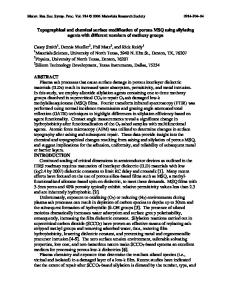Chemical Modification of the Porous Silicon Surface
- PDF / 272,569 Bytes
- 6 Pages / 414.72 x 648 pts Page_size
- 58 Downloads / 486 Views
,,./ - •S
six s -
PS-H
SiS •-Si Sde--ýSi... PS-OEt
.. eSI i / -H PS-O-
._Si( Si._XSi..
.. Sie Si. Si_.
PS-OSiEt 3
PS-OOCH
Figure 1. Five types of PS surfaces prepared and studied in this report.
Two chemical reactions have been developed to modify the Si surface. 1 Bromination of the PS followed by introduction of an alcohol results in
387
Mat. Res. Soc. Symp. Proc. Vol. 358 01995 Materials Research Society
formation of an Si-O bond with pendant 'Si B CH3CH2OH B2 hydrocarbon, 10Si --Si' -- _ Si Scheme 1. This reaction can be used H Electrochemical Reaction to produce a wide range of surface HCOOH / H 0.1 MHCOONa I Si W Si groups. In this e - si/ 'si- -si/j si-. report we will discuss PS derivScheme 1. Si surface reaction schemes. atized with simple alcohols and silanols. A second reaction is electrochemical deposition of carboxylic acids, Scheme 1. Bromination Reaction
H SiI
SI
H
BROMINATION REACTIONS PS under -2 mtorr vacuum is exposed to Br 2 vapor for 5 minutes. Br2 is removed by condensing into a liquid nitrogen trap, and the sample is kept under vacuum for 10 minutes. The alcohol is introduced as a liquid or gas and is allowed to react for 5-10 minutes, whereupon it is drained and sample is dried under vacuum. The reaction chamber is constructed so as to hold the sample fixed with respect to PL excitation source and detector during the I1
I
I
I
I
X
Before Reaction
I
I
=660 nm
After Reaction Before LReaction After Reaction-
850
800
650 700 750 wavelength (nm)
550
600
0
20
40
60
1 00x1 0-6
microseconds (10s)
Figure 2. Steady-state (left) and transient (right) emission of PS derivatized with alcohol in the manner described in text.
388
4000
3500
2500
3000
1500
2000
1000
500
wavenumber (cm'") Figure 3. IR spectra of as-etched hydride-terminated PS-H (dotted line) and ethoxide-
derivatized PS-OEt (line).
procedure. The resulting alkoxide-derivatized PS retains 10-40% of the initial PS emission intensity, Fig. 2. The steady-state spectral profile before and after derivatization is essentially unchanged except in intensity and the transient emission has a similar initial intensity but with an attenuated lifetime. Chemical modification of the surface introduces new non-radiative
recombination pathways but ..........PS-O-
..... PSmOSiEtc
4000
does not change the radiative
V Osi-H V Si-H
3000
\
2000
x
h mechanism.
I
1000
wavenumber (cm") Figure 4. IR Spectra of PS-O- and PS-OSi(Et) 3 (top) and a PS surface decorated with thiophene monomer (bottom).
389
Reaction products are identified by diffuse-reflectance IR. The IR spectrum of asetched PS-H 2 is dominated by a strong Si-H stretch at 2110 cm- 1. Further assignments are made in Figure 3. Derivatization by ethanol introduces C-H stretches in the 3000 cm-1 region and Si-O around 1100 cm- 1. Hydride stretches on Si backbonded to 0 occur at 2253 ± 2 cm-1, Fig. 3. Broad absorptions at 3500 cm- 1 are from residual water. Reaction of brominated PS with H2 0 results in
formation of a surface oxide, PS-O-, Fi
Data Loading...




